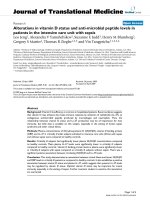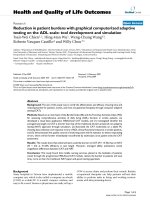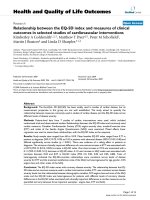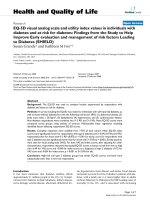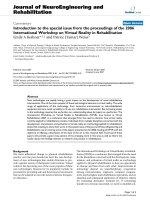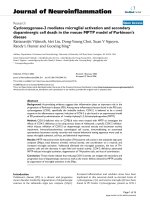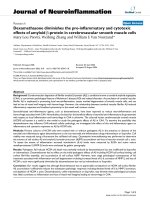báo cáo hóa học:" Substitutions in the Reverse Transcriptase and Protease Genes of HIV-1 Subtype B in Untreated Individuals and Patients Treated With Antiretroviral Drugs" potx
Bạn đang xem bản rút gọn của tài liệu. Xem và tải ngay bản đầy đủ của tài liệu tại đây (343.45 KB, 6 trang )
BioMed Central
Page 1 of 6
(page number not for citation purposes)
Journal of the International AIDS
Society
Open Access
Research article
Substitutions in the Reverse Transcriptase and Protease Genes of
HIV-1 Subtype B in Untreated Individuals and Patients Treated
With Antiretroviral Drugs
Dan Turner
1
, Bluma Brenner
2
, Daniela Moisi
3
, Chen Liang
4
and
Mark A Wainberg*
5
Address:
1
Fellow in HIV Medicine, McGill University, Montreal, Quebec, Canada,
2
Assistant Professor, Department of Surgery, McGill University,
Montreal, Quebec, Canada,
3
Research Associate, McGill University, Montreal, Quebec, Canada,
4
Assistant Professor, Department of Microbiology,
McGill University, Montreal, Quebec, Canada and
5
Director McGill University AIDS Centre, Montreal, Quebec, Canada
Email: Mark A Wainberg* -
* Corresponding author
Abstract
The nucleotide transition GA is known as a hypermutation due to its high prevalence in HIV-1
and other pathogens. However, the contribution of the GA transition in the generation of drug
resistance mutations is unknown. Our objective was to ascertain the rate of nucleotide
substitutions in protease (PR) and reverse transcriptase (RT) in both untreated and treated HIV-1
patients. Genotypic analysis was performed on viruses from both treated and untreated patients
with subtype B infections. Nucleotide genomic diversity was compared with a consensus subtype
B reference virus. Then, the prevalence of resistance-associated mutations in different subgroups
of treated patients was evaluated in relation to the patterns of nucleotide transitions. In untreated
patients (n = 50) GA was most prevalent, followed by AG, CT, and TC transitions. In
treated patients (n = 51), the prevalence of AG was similar to that of GA. Among mutations
that confer resistance to antiretroviral drugs, M184V was present in 76% of treated patients and
K70R in 31% (AG transitions). Other frequent mutations in RT included T215Y (CA and AT
substitutions), which was prevalent in 31% of treated patients. In PR, a L90M (TA substitution)
was prevalent in 47% of protease inhibitor (PI)-treated patients. In conclusion, the GA transition
was most prevalent in RT and PR among untreated patients. In contrast, AG was the most
prevalent transition in patients treated with antiretroviral drugs.
Introduction
The genetic diversity of HIV-1 is a subject of growing con-
cern in regard to both diagnosis of HIV infection as well
as expectations of responsiveness to antiretroviral therapy.
Resistance mutations to antiretroviral drugs (ARVs) arise
spontaneously as a result of the error-prone replication of
HIV-1 and, in addition, are selected both in vitro and in
vivo by pharmacologic pressure.[1-3] The high rate of
spontaneous mutation in HIV-1 has been largely attrib-
uted to the absence of a 3'5'exonuclease proofreading
mechanism. Sequence analyses of HIV-1 DNA have
detected several types of mutations, including base substi-
tutions, additions, and deletions.[1] The frequency of
spontaneous mutation for HIV-1 varies considerably as a
result of differences among viral strains studied in
vitro.[3] Overall mutation rates for wild-type laboratory
strains of HIV-1 have been reported to range from 0.97 ×
10
-2
to 2 × 10
-2
per nucleotide for HXB2 to as high as 8 ×
Published: 23 March 2005
Journal of the International AIDS Society 2005, 7:69
This article is available from: />Journal of the International AIDS Society 2005, 7:69 />Page 2 of 6
(page number not for citation purposes)
10
-2
per nucleotide for the HIV-1 NY5 strain.[1-4] The
rapid appearance of such mutations is, in part, a result of
low fidelity during reverse transcription.
A large proportion of nucleotide substitutions that cause
amino-acid changes in HIV-1 favor a guanosine-to-adeno-
sine (GA) transition.[5-8] The GA transition plays an
important role in viral evolution as well as in the escape
of HIV-1 from the host immune response. However, the
contribution of the GA transition relative to other tran-
sitions in treated patients receiving ARVs and the genera-
tion of drug resistance mutations has not been fully
assessed. To address this issue, we analyzed the rate of dif-
ferent nucleotide substitutions in clinical samples in the
RT and PR regions.
Materials and methods
Study Populations
This study was carried out using plasma obtained from
patients who were followed in our clinic from among a
group of initially ARV-naive patients (n = 50) having viral
loads > 1000 copies/mL. A second group included ARV-
experienced patients in whom viral load was > 1000 cop-
ies/mL and in whom genotypic analysis was performed (n
= 51). Plasma was obtained during 20002001. All subjects
harbored subtype-B HIV-1 viruses and provided informed
consent.
Sequencing of the RT and PR Genes
Toward this purpose, RNA was extracted using the
QIAamp kit and RNA products were amplified by
polymerase chain reaction (PCR) as described.[9] The
sequencing of DNA products was carried out by standard
methodology using kits (TruGene ) obtained from Bayer
Diagnostics Inc. (Toronto, Ontario, Canada). The
sequencing of RT was limited to positions 38249 due to
the type of assay performed. Sequencing of both the RT
and PR genes was also employed to determine the sub-
types of these viral isolates in concert with the Stanford
database />. Nucleotide genomic
diversity in the RT and PR regions of the various viral iso-
lates was compared with a consensus subtype B reference
virus, LAV-1 (
; accession number
M19921).
Statistical Analysis
The distribution of nucleotide substitutions was deter-
mined for each patient and the mean value for each type
of substitution was calculated. Differences among types of
nucleotide substitutions were determined by 1-way anal-
ysis of variance, followed by Tukey's multiple comparison
test. Statistical analyses were performed using Prism soft-
ware (version 3.0, GraphPad Software, Inc.).
Results
Nucleotide Substitutions Among Drug-Naive Patients
The distribution of nucleotide substitutions relative to the
subtype B reference in nontreated patients is shown in Fig-
ure 1. The mean of the GA hypermutation was 8.2 (95%
confidence interval [CI], 7.39.1) compared with AG
nucleotide transitions, which was 6.5 (95% CI, 5.87.1) (P
< .001). This was followed by 2 other relatively frequent
transitions, cytosine (C) thymidine (T) and TC.
Nucleotide Substitutions Among ARV-Experienced
Patients
To ascertain the distribution of nucleotide transitions in
treated patients, we analyzed the sequences of 51 ARV-
treated patients, all of whom had received nucleoside
reverse transcriptase inhibitors (NRTIs) (Figure 2); the dis-
tribution of treatments in these individuals is described in
the Table 1. The mean of GA transitions was 8.1 (95%
CI, 7.39), which was similar to the incidence of the AG
transition 7.7 (95% CI, 6.78.7). The mean of CT and
TC transitions (4.2 and 3.9 mutations, respectively) was
lower than that of either AG or GA (P < .001). Among
patients treated with PIs (n = 34), the mean of AG tran-
sitions was 8.5 (95% CI, 7.49.6), which was higher than
the incidence of the GA transition 5.7 (95% CI, 4.76.7)
(P < .001) (data not shown). We did not analyze the data
among patients treated by nonnucleoside reverse tran-
scriptase inhibitors (NNRTIs) (n = 12) due to the fact that
8 of them had also been treated with PIs.
Numbers of nucleotide substitutions in RT and PR in untreated patientsFigure 1
Numbers of nucleotide substitutions in RT and PR in
untreated patients. (Values represent means for each
transition between patients ± standard error of the mean).
9
8
7
6
5
4
3
2
Substitutions
Number of Substitutions
1
0
A → G
G → A
C → T
T → C
A → C
C → A
T → G
G → T
T → A
A → T
C → G
G → C
(a)
Journal of the International AIDS Society 2005, 7:69 />Page 3 of 6
(page number not for citation purposes)
Nonresistance Positions
In order to ascertain whether the distribution of nucle-
otide substitutions was related to positions known to con-
fer resistance, we conducted an analysis, which excluded
all positions known to be associated with drug resistance.
In the untreated group, the mean of GA transitions, ie,
7.1 (95% CI, 6.37.9) was significantly higher than that of
AG transitions, ie, 6.1 (95% CI, 5.56.7) (P < .05) (Fig-
ure 3). In contrast, the mean of GA transitions in treated
patients was 3.5 (95% CI, 2.94.1), which was less than
that of AG transitions, ie, 5.1 (95% CI, 4.45.8) (P < .01)
(Figure 4). Among patients treated with PIs, the mean of
AG transitions was 5.8 (95% CI, 56.6), which was
higher than the incidence of the GA transition, ie, 3.6
(95% CI, 2.84.4) (P < .001) (data not shown).
We also evaluated the prevalence of resistance-coassoci-
ated mutations (as defined by a IAS-USA consensus panel,
October 2003) in relation to different nucleotide transi-
tions in 3 groups of treated individuals, ie, patients who
had received both PIs and NRTIs, both NNRTIs and
NRTIs, or only NRTIs. The different regions of RT and PR
were analyzed based on the types of drugs employed in
therapy. Among major resistance mutations, 47% of PI-
treated patients harbored the L90M mutation, which
results from a TA transversion. In contrast, only 14.7%
harbored D30N and 11.7% harbored M46I, both of
which result from a GA transition.
Among all ARV-treated patients, 76.4% harbored M184V
and 31.3% harbored K70R, both of which result from a
AG transition. Another high-prevalence mutation was
T215Y (33.3% of patients), which is a result of both CA
and AT transversions. Among NNRTI-treated patients,
33.3% harbored the Y181C mutation, which results from
a AG transition. G190A occurred in 25% of patients
(GC) as did V108I (GA).
Discussion
This study reports that the prevalence of the GA hyper-
mutation in treated patients was decreased compared with
the prevalence in untreated patients. For convenience, we
compared sequences in our patient populations with
those of the LAV-1 reference virus, which is of ancestral
importance. Although LAV-1 might itself have some
unique sequences, this would not have affected our anal-
ysis, which compared LAV-1 isolates from both treated
and untreated patients. The RT and PR enzymes are the
most important targets of antiretroviral therapy, and
mutations at different positions in the pol gene can confer
resistance to different ARVs.
Some of the resistance mutations that result from a GA
transition confer only low levels of resistance when they
appear alone, such as K20R and V32I in PR and D67N and
G333A in RT. Other mutations resulting from GA tran-
sitions may occur rarely, such as V82T (the preferred
mutation in this position is V82A, which results from a
TC transition). In RT, V75T which confers resistance to
Numbers of nucleotide substitutions in RT and PR in untreated patients, excluding positions responsible for resist-ance mutations as defined by a IAS-USA consensus panel, October 2003Figure 3
Numbers of nucleotide substitutions in RT and PR in
untreated patients, excluding positions responsible
for resistance mutations as defined by a IAS-USA
consensus panel, October 2003. (Values represent
means for each transition between patients ± standard error
of the mean.)
8
7
6
5
4
3
2
Substitutions
Number of Substitutions
1
0
A → G
G → A
C → T
T → C
A → C
C → A
T → G
G → T
T → A
A → T
C → G
G → C
(a)
Numbers of nucleotide substitutions in RT and PR in treated individualsFigure 2
Numbers of nucleotide substitutions in RT and PR in
treated individuals. (Values represent means for each
transition between patients ± standard error of the mean).
9
8
7
6
5
4
3
2
Substitutions
Number of Substitutions
1
0
A → G
G → A
C → T
T → C
A → C
C → A
T → G
G → T
T → A
A → T
C → G
G → C
(b)
Journal of the International AIDS Society 2005, 7:69 />Page 4 of 6
(page number not for citation purposes)
Table 1: Prevalence of Patients Harboring Different Resistance Mutations
Region
sequence
d and
number
of isolates
examined
Nucleotide changes (%)
GAAGCTTCACCATGGTTAATCGGC
PR
(n = 34)
K20R
(2.9)
I47V
(2.9)
L10F (0) V82A/S
(17.6)
I47V (0) L10I
(17.6)
L10R
(5.8)
G48V
(11.7)
L24I (0) K20M
(2.9)
L10V
(5.8)
M46L (0)
D30N
a
(14.7)
I50V (0) I54L (2.9) L90M
(47)
M46L
(17.6)
I54M
(2.9)
G73S (0)
V32I
(2.90)
I54V
(14.7)
M36I
(29.4)
I84V
(11.7)
M46I
(11.7)
N88D/S
(8.8)
A71T
(8.8)
G73S
(11.7)
V77I
(8.8)
V82T
(5.8)
RT (NRTI)
(n = 51)
D67N
(19.6)
K65R (0) A62V (0) F77L (0) M41L
(21.5)
Q151M
(3.9)
L74V
(3.9)
V75I (0) F116Y
(1.9)
M41L
(21.5)
F77G
(1.9)
V75I (5.9) K70R
(31.3)
T215F
(11.7)
E44A/D
(5.8)
T215Y
(33.3)
L210W
(25.4)
E44D (0)
V118I
(25)
M184V
(76.4)
K219Q
(7.8)
Q151M
(3.9)
G333A
(NA)
K219E
(11.7)
T215F
(11.7)
T215Y
(33.3)
RT
(NNRTI)
(n = 12)
V108I
(25)
Y181C
(33.3)
P236L (0) V106A
(0)
K103N
(9.6)
P225H
(0)
L100I
(8.3)
K103N
(8.3)
G190A
(25)
G190S
(0)
Y188C
(0)
Y188H/L
(16.6)
M230L
(0)
Y188L
(9.6)
Y188L
(9.6)
G190S
(0)
a
The major mutations in PR are in bold
Journal of the International AIDS Society 2005, 7:69 />Page 5 of 6
(page number not for citation purposes)
stavudine only occurred in 4% of patients treated with this
drug.[10] Of note, some of the common resistance muta-
tions that are easily selected by drugs in vivo and in cell
culture involve AG transitions, eg, M184V and Y181C.
To assure that drug resistance mutation sites did not bias
the total results obtained, we also analyzed the prevalence
of substitutions in RT and PR while excluding codons
known to be associated with drug resistance. Again, we
observed a decrease in prevalence of GA transitions and
even an increased prevalence of AG transitions.
The clinical importance of the GA hypermutation in
HIV-1 is not clear. It has been shown previously both in
vitro and in vivo that the GA nucleotide substitution is
the most frequent.[11-18] In contrast, studies on intrapa-
tient sequence variation of the gag gene found no differ-
ences between proportions of GA and AG
transitions.[19]
A V106M mutation in RT is preferentially selected both in
vitro and in vivo by the NNRTI efavirenz in subtype C
viruses and confers high-level cross-resistance to all 3 cur-
rently approved NNRTIs.[20] The selection of this muta-
tion in subtype C viruses results from a single nucleotide
change from wild-type in subtype C viruses (GTGATG).
The GA hypermutation is the cause of the M184I substi-
tution which commonly occurs prior to M184V.[21]
However, M184I is rare in clinical samples and the switch
from isoleucine to valine results from a AG transition.
Consideration of viral fitness or replication capacity may
have an impact on the likelihood that a given substitution
may ultimately prevail in cases in which several different
changes may confer resistance to the same drug.[22] Sex-
ual transmission of a HIV-1 F subtype virus that contains
GA hypermutations has been reported in 1 case, but the
GA hypermutation could no longer be detected in the
transmitting patient after 1 year on ARV therapy.[23]
GA hypermutations may involve asymmetric endog-
enous deoxynucleotide triphosphate (dNTP) pools, with
deoxycytidine triphosphate (dCTP) and deoxyguanosine
triphosphate (dGTP) being present at the lowest levels,
while dCTP/dTTP (deoxythymidine triphosphate) ratios
range between 1:2 and 1:6.[24] Thus, the GA hypermu-
tation in HIV has been directly linked to a dCTP pool
imbalance during reverse transcription.[18,25,26] In one
study, antimetabolic drugs were shown to reverse GA
hypermutations in favor of AG transitions, by increas-
ing the intracellular ratio of dCTP/dTTP.[27]
An alternative important cause of GA hypermutation
may involve a cellular factor, APOBEC3G, a cytidine
deaminase that converts cytosine to uracil. The activity of
APOBEC3G is inhibited by the Vif protein.[5,7,8] In the
absence of Vif, the synthesis of the negative strand of DNA
can result in the insertion of a uracil as a result of the
deamination of a cytosine, leading to the inclusion of an
adenosine instead of guanosine in positive-stranded
cDNA. This results in mutant viruses that contain several
GA changes. With cell passage, more GA mutations in
viral DNA occur and infectivity is diminished. Further-
more, trace amounts of APOBEC3G are found within
virus particles.[28] In contrast, mutant viruses that lack
the vif gene contain higher levels of APOBEC3G. Such
viruses cannot complete normal reverse transcription.
This Vif-APOBEC3G interaction might explain certain
cases of diminished viral fitness; hence, this interaction
may be a target for future drug development.
In our descriptive study, the GA transition was the most
frequent mutation observed among untreated patients,
and this may be a result of spontaneous mutation. In con-
trast, the GA hypermutation was not more prevalent in
treated patients than AG transitions, and in PI-treated
patients AG was even more prevalent. Thus, patterns of
nucleotide substitutions in the pol gene are different in
treated vs untreated individuals.
Further biochemical and clinical analysis will be needed
to understand the full importance of these different pat-
terns of nucleotide substitutions in HIV-1 isolated from
both treated and untreated individuals.
Numbers of nucleotide substitutions in RT and PR in treated
individuals, excluding positions responsible for resistance mutations as defined by a IAS-USA consensus panel, October 2003Figure 4
Numbers of nucleotide substitutions in RT and PR in
treated individuals, excluding positions responsible
for resistance mutations as defined by a IAS-USA
consensus panel, October 2003. (Values represent
means for each transition between patients ± standard error
of the mean.)
8
7
6
5
4
3
2
Substitutions
Number of Substitutions
1
0
A → G
G → A
C → T
T → C
A → C
C → A
T → G
G → T
T → A
A → T
C → G
G → C
(b)
Journal of the International AIDS Society 2005, 7:69 />Page 6 of 6
(page number not for citation purposes)
Authors and Disclosures
Dan Turner, MD, has disclosed no relevant financial rela-
tionships.
Bluma Brenner, PhD, has disclosed no relevant financial
relationships.
Daniela Moisi, MSc, has disclosed no relevant financial
relationships.
Chen Liang, PhD, has disclosed no relevant financial rela-
tionships.
Mark A. Wainberg, PhD, has disclosed no relevant finan-
cial relationships.
Acknowledgements
Dan Turner has received fellowship support from the Canadian HIV Trials
Network.
We are also grateful to Aldo and Diane Bensadoun for support of our
work.
References
1. Preston BD, Dougherty JP: Mechanisms of retroviral mutation.
Trends Microbiol 1996, 4:16-21. Abstract
2. Quinones-Mateu M, Weber J, Rangel H, Charkaborty B: HIV-1 fit-
ness and antiretroviral drug resistance. AIDS Rev 2001,
3:223-242.
3. Rezende LF, Drosopoulos WC, Prasad VR: The influence of 3TC
resistance mutation M184I on the fidelity and error specifi-
city of human immunodeficiency virus type 1 reverse tran-
scriptase. Nucleic Acids Res 1998, 26:3066-3072. Abstract
4. Roberts J, Bebenek K, Kunkel T: The accuracy of reverse tran-
scriptase from HIV-1. Science 1998, 242:1171-1173.
5. Harris RS, Bishop KN, Sheehy AM, et al.: DNA deamination medi-
ates innate immunity to retroviral infection. Cell 2003,
113:803-809. Abstract
6. Lecossier D, Bouchonnet F, Clavel F, Hance AJ: Hypermutation of
HIV-1 DNA in the absence of the Vif protein. Science 2003,
300:1112.
7. Mangeat B, Turelli P, Caron G, Friedli M, Perrin L, Trono D: Broad
antiretroviral defence by human APOBEC3G through lethal
editing of nascent reverse transcripts. Nature 2003,
424:99-103. Abstract
8. Zhang H, Yang B, Pomerantz RJ, Zhang C, Arunachalam SC, Gao L:
The cytidine deaminase CEM15 induces hypermutation in
newly synthesized HIV-1 DNA. Nature 2003, 424:94-98.
Abstract
9. Salomon H, Wainberg M-A, Brenner B, et al.: Prevalence of HIV-1
resistant to antiretroviral drugs in 81 individuals newly
infected by sexual contact or injecting drug use. Investiga-
tors of the Quebec Primary Infection Study. AIDS 2000,
14:F17-F23. Abstract
10. Ross L, Fisher R, Scaesella A: Patients failing on stavudine-based
therapies that have developed thymidine analogue muta-
tions; multidrug resistance or V75T mutations have reduced
phenotypic susceptibility to stadivudine. Antiviral Therapy 2000,
5:38-39.
11. Borman AM, Quillent C, Charneau P, Kean KM, Clavel F:
A highly
defective HIV-1 group O provirus: evidence for the role of
local sequence determinants in G > A hypermutation dur-
ing negative-strand viral DNA synthesis. Virology 1995,
208:601-609. Abstract
12. Delassus S, Cheynier R, Wain-Hobson S: Evolution of human
immunodeficiency virus type 1 nef and long terminal repeat
sequences over 4 years in vivo and in vitro. J Virol 1991,
65:225-231.
13. Fitzgibbon JE, Mazar S, Dubin DT: A new type of G > A hypermu-
tation affecting human immunodeficiency virus. AIDS Res Hum
Retroviruses 1993, 9:833-838. Abstract
14. Goodenow M, Huet T, Saurin W, et al.: HIV-1 isolates are rapidly
evolving quasispecies: evidence for viral mixtures and pre-
ferred nucleotide substitutions. J Acquir Immune Defic Syndr 1989,
2:344-352. Abstract
15. Janini M, Rogers M, Birx DR, McCutchan FE: Human immunodefi-
ciency virus type 1 DNA sequences genetically damaged by
hypermutation are often abundant in patient peripheral
blood mononuclear cells and may be generated during near-
simultaneous infection and activation of CD4(+) T cells. J
Virol 2001, 75:7973-7986. Abstract
16. Liu Y, Tang XP, McArthur JC, Scott J, Gartner S: Analysis of human
immunodeficiency virus type 1 gp160 sequences from a
patient with HIV dementia: evidence for monocyte traffick-
ing into brain. J Neurovirol 2000, 6(suppl 1):S70-S81. Abstract
17. Monken CE, Wu B, Srinivasan A: High resolution analysis of HIV-
1 quasispecies in the brain. AIDS 1995, 9:345-349. Abstract
18. Vartanian JP, Meyerhans A, Asjo B, Wain-Hobson S: Selection,
recombination, and GA hypermutation of human
immunodeficiency virus type 1 genomes. J Virol 1991,
65:1779-1788. Abstract
19. Yoshimura FK, Diem K, Learn GH, Riddell S Jr, Corey L: Intrapa-
tient sequence variation of the gag gene of human immuno-
deficiency virus type 1 plasma virions. J Virol 1996,
70:8879-8887. Abstract
20. Brenner B, Turner D, Oliveira M, et al.: A V106M mutation in
HIV-1 clade C viruses exposed to efavirenz confers cross-
resistance to non-nucleoside reverse transcriptase inhibi-
tors.
AIDS 2003, 17:F1-F5.
21. Keulen W, Back NK, van Wijk A, Boucher CA, Berkhout B: Initial
appearance of the 184Ile variant in lamivudine-treated
patients is caused by the mutational bias of human immuno-
deficiency virus type 1 reverse transcriptase. J Virol 1997,
71:3346-3350. Abstract
22. Keulen W, Boucher C, Berkhout B: Nucleotide substitution pat-
terns can predict the requirements for drug-resistance of
HIV-1 proteins. Antiviral Res 1996, 31:45-57. Abstract
23. Caride E, Brindeiro RM, Kallas EG, et al.: Sexual transmission of
HIV-1 isolate showing G > A hypermutation. J Clin Virol 2002,
23:179-189.
24. Meyerhans A, Vartanian JP, Hultgren C, et al.: Restriction and
enhancement of human immunodeficiency virus type 1 rep-
lication by modulation of intracellular deoxynucleoside tri-
phosphate pools. J Virol 1994, 68:535-540. Abstract
25. Martinez MA, Vartanian JP, Wain-Hobson S: Hypermutagenesis of
RNA using human immunodeficiency virus type 1 reverse
transcriptase and biased dNTP concentrations. Proc Natl Acad
Sci USA 1994, 91:11787-11791. Abstract
26. Vartanian JP, Meyerhans A, Sala M, Wain-Hobson S: G > A hyper-
mutation of the human immunodeficiency virus type 1
genome: evidence for dCTP pool imbalance during reverse
transcription. Proc Natl Acad Sci USA 1994, 91:3092-3096. Abstract
27. Balzarini J, Camarasa MJ, Perez-Perez MJ, et al.: Exploitation of the
low fidelity of human immunodeficiency virus type 1 (HIV-1)
reverse transcriptase and the nucleotide composition bias in
the HIV-1 genome to alter the drug resistance development
of HIV. J Virol 2001, 75:5772-5777. Abstract
28. Trono D: Innate intracellular antiretroviral defences. Program
and Abstracts of the 2nd IAS Conference on HIV Pathogenesis and Treat-
ment; July 1316, 2003; Paris, France . Abstract 121

